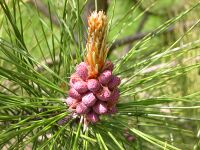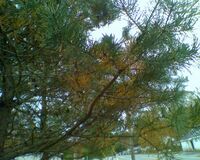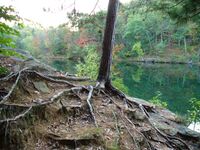صنوبر راتنجي
| Red pine | |
|---|---|
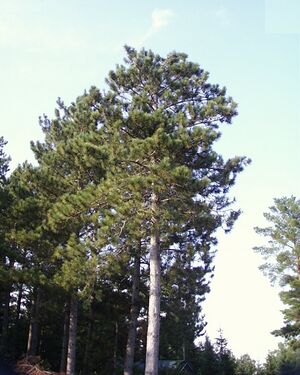
| |
| Trees at Sherburne NWR, Minnesota | |
| التصنيف العلمي | |
| أصنوفة غير معروفة (أصلحها): | Pinus subsect. Pinus |
| Species: | Template:Taxonomy/PinusP. resinosa
|
| Binomial name | |
| Template:Taxonomy/PinusPinus resinosa | |
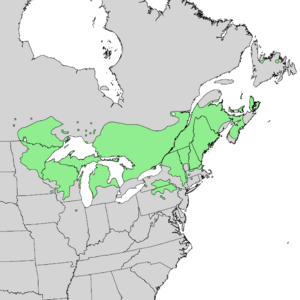
| |
صنوبر النرويج أو الصنوبر الأحمر Pinus resinosa هو شجرة صنوبر صغيرة لمتوسطة الارتفاع (20 - 30 متر)، موطنها الأصلي شرق أمريكا الشمالية. وتتهجن أحياناً مع صنوبريات أخرى.[2][3] (also Norway pine in Minnesota),[4] is a pine native to North America.[5]
خشبه متين وشديد التحمل، ينمو بالفطرة في شرقي أمريكا الشمالية. ويستخدم في الأشغال الإنشائية من جميع الأنواع، والمباني والجسور، وفلنكات السكك الحديدية، والقوارب.
. . . . . . . . . . . . . . . . . . . . . . . . . . . . . . . . . . . . . . . . . . . . . . . . . . . . . . . . . . . . . . . . . . . . . . . . . . . . . . . . . . . . . . . . . . . . . . . . . . . . . . . . . . . . . . . . . . . . . . . . . . . . . . . . . . . . . . . . . . . . . . . . . . . . . . . . . . . . . . . . . . . . . . . .
الوصف
Red pine is a coniferous evergreen tree characterized by tall, straight growth.[6] It usually ranges from 20–35 metres (66–115 feet) in height and 1 m (3 ft 3 in) in trunk diameter, exceptionally reaching 43.77 m (143+1⁄2 ft) tall.[7] The crown is conical, becoming a narrow rounded dome with age. The bark is thick and gray-brown at the base of the tree, but thin, flaky and bright orange-red in the upper crown; the tree's name derives from this distinctive character. Some red color may be seen in the fissures of the bark. The species is self pruning; there tend not to be dead branches on the trees, and older trees may have very long lengths of branchless trunk below the canopy.[5]
The leaves are needle-like, dark yellow-green, in fascicles of two,[6] 12–18 centimetres (4+3⁄4–7 inches) long, and brittle. The leaves snap cleanly when bent; this character, stated as diagnostic for red pine in some texts, is however shared by several other pine species. The cones are symmetrical ovoid, 4–6 cm (1+1⁄2–2+1⁄4 in) long by 2.5 cm (1 in) broad, and purple before maturity, ripening to nut-blue and opening to 4–5 cm (1+1⁄2–2 in) broad, the scales without a prickle and almost stalkless.[2]
The pine grows well in sandy soils and on soils which are too poor for White Pine. [5]
النسب
Red pine is notable for its very constant morphology and low genetic variation throughout its range, suggesting it has been through a near extinction in its recent evolutionary history.[8][9] A genetic study of nuclear microsatellite polymorphisms among populations distributed throughout its natural range found that red pine populations from Newfoundland are genetically distinct from most mainland populations, consistent with dispersal from different glacial refugia in this highly self-pollinating species.[10]
An old tree in Itasca State Park, Minnesota

Cone (scale in cm)
Red pine boughs, showing yellowing and abscission of older foliage in the autumn.
التوزع والموئل
It occurs from Newfoundland west to Manitoba, and south to Pennsylvania, with several smaller, disjunct populations occurring in the Appalachian Mountains in Virginia and West Virginia, as well as a few small pockets in extreme northern New Jersey and northern Illinois.[1][11]
It can be found in a variety of habitats.[5]
البيئة
It is intolerant of shade, but does well in windy sites; it grows best in well-drained soil. It is a long-lived tree, reaching a maximum age of about 500 years.[12]
الاستخدامات
The wood is commercially valuable in forestry for timber and paper pulp, and the tree is also used for landscaping.[5]
The wood is light, hard, and very close grained. It is not durable in contact with soil without chemical treatment. It is used in construction for piling, masts, spars, boxes, and crates.[5]
في الثقافة
The red pine is Minnesota's state tree.[13] In Minnesota the use of the name "Norway"[4] may stem from early Scandinavian immigrants who likened the American red pines to the Scots pines back home.[14]
الهامش
- ^ أ ب Farjon, A. (2013). "Pinus resinosa". IUCN Red List of Threatened Species. 2013: e.T42410A2978087. doi:10.2305/IUCN.UK.2013-1.RLTS.T42410A2978087.en. Retrieved 11 November 2021.
- ^ أ ب Moore, Gerry; Kershner, Bruce; Tufts, Craig; et al. (May 9, 2008). National Wildlife Federation Field Guide to Trees of North America. New York: Sterling Publishing. p. 66. ISBN 978-1-4027-3875-3.
- ^ "Red Pine". dnr.state.mn.us. Minnesota Department of Natural Resources.
- ^ أ ب Hoyt, Richard (21 September 2017). "Red Pine Tree Facts". gardenguides.com. Retrieved 24 February 2022.
- ^ أ ب ت ث ج ح Grimm, William Carey (1966). The Book of Trees (in الإنجليزية). Harrisburg, Pennsylvania: The Stockpole Company. p. 43.
- ^ أ ب قالب:EFloras
- ^ قالب:Gymnosperm Database
- ^ Fowler, D. P.; Morris, R. W. (1977). "Genetic diversity in Red Pine: evidence for low genic heterozygosity". Canadian Journal of Forest Research. 7 (2): 343–347. doi:10.1139/x77-043.
- ^ Simon, Jean-Pierre; Bergeron, Yves; Gagnon, Daniel (1986). "Isozyme uniformity in populations of Red Pine (Pinus resinosa) in the Abitibi Region, Quebec". Canadian Journal of Forest Research. 16 (5): 1133–1135. doi:10.1139/x86-198.
- ^ Jacquelyn Boys; Marilyn Cherry; Selvadurai Dayanandan (2005). "Microsatellite Analysis Reveals Genetically Distinct Populations of Red Pine". American Journal of Botany. 92 (5): 833–841. doi:10.3732/ajb.92.5.833. PMID 21652464.
- ^ قالب:Illinois Wildflowers
- ^ "Eastern OLDLIST: A database of maximum tree ages for Eastern North America". Columbia Climate School, Columbia University. Retrieved February 24, 2022 – via ldeo.columbia.edu.
- ^ "State Tree- Norway Pine". sos.state.mn.us. Minnesota Secretary of State.
- ^ Wright, Jacob J. (September 21, 2017). "What is a Norway Pine Tree?". gardenguides.com. Archived from the original on June 27, 2019. Retrieved February 24, 2022.
- Short description is different from Wikidata
- Articles with hatnote templates targeting a nonexistent page
- Missing redirects
- أنواع القائمة الحمراء غير المهددة
- Automatic taxobox cleanup
- Pinus
- Trees of humid continental climate
- Flora of Eastern Canada
- Least concern flora of the United States
- Trees of Northern America
- أشجار الولايات المتحدة
- أشجار كندا
- Plants used in bonsai
- أشجار الزينة
- Flora of Massachusetts
- Trees of North Carolina
- صنوبريات
- Least concern plants


